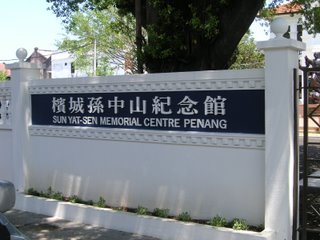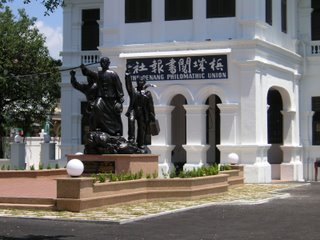
Penang changed the course of history in China. Without the Penang Conference in 1910, where Dr. Sun Yat Sen, the founder of modern China, pleaded with his overseas Chinese supporters to support him financially for the last fight against the Manchu rule in China, the course of chinese history may be different.
Read it in : http://www.sysmuseum-pg.com/selection.html
Many old-timers remember the time when the founding president of the Republic of China came and lived in Penang. He came to Pg as a political refugee on the run from the Ching (Manchu) Government of China. He had failed to rally the people of China to his cause i.e. to overthrow the Manchu government and set up a republic; his planned revolt failed and had to flee for his life.
He was dispirited and discouraged. In Penang as well as elsewhere, where there is a huge overseas chinese population, he successfully rallied the overseas chinese to his cause.....it is a measure of truth to say that he was not only financed mainly through his overseas chinese connections but also received much support and encouragement from the overseas chinese communities throughout the world (Dr. Sun Yat Sen was overseas chinese himself, having been raised in Hawaii)

Many chinese in Penang supported Dr. Sun, none more than the two millionaires in this sculpture together with him. They supported Dr. Sun and his cause till they bankrupted themselves...... Modern China owes these two people and overseas chinese all over the world a debt....if not for their support...who knows china may still be under imperial rule....and history would had turn up differently...
from wikipeadia
Sun and the overseas Chinese
Sun's notability and popularity extends beyond the Greater China region, particularly to Nanyang where a large concentration of overseas Chinese reside in Singapore. Sun recognised the contributions which the large number of overseas Chinese can make beyond the sending of remittances to their ancestral homeland, and therefore made multiple visits to spread his revolutionary message to these communities around the world.
Sun made a total of eight visits to Singapore between 1900 and 1911. His first visit made on 7 September 1900 was to rescue Miyazaki Toten, who was arrested there, an act which also resulted in his own arrest and a ban from visiting the island for five years. Upon his next visit in June 1905, he met local Chinese merchants Teo Eng Hock, Tan Chor Nam and Lim Nee Soon in a meeting which was to mark the commencement of direct support from the Nanyang Chinese. Upon hearing their reports on overseas Chinese revolutionists organising themselves in Europe and Japan, he urged them to establish the Singapore chapter of the Tongmenghui, which came officially into being on 6 April the following year upon his next visit.
The chapter was housed in a villa known as Wan Qing Yuan (晚晴園) and donated for the use of revolutionalists by Teo. In 1906, the chapter grew in membership to 400, and in 1908, when Sun was in Singapore to escape the Qing government in the wake of the failed Zhennanguan Uprising, the chapter had become the regional headquarters for Tongmenghui branches in Southeast Asia. Sun and his followers travelled from Singapore to Malaya and Indonesia to spread their revolutionary message, by which time the alliance already had over twenty branches with over 3,000 members around the world.
Sun's foresight in tapping on the help and resources of the overseas Chinese population was to bear fruit on his subsequent revolutionary efforts. In one particular instance, his personal plea for financial aid at the Penang Conference held on 13 November 1910 in Malaya, helped launch a major drive for donations across the Malay Peninsula, an effort which helped finance the Second Guangzhou Uprising (also commonly known as the Yellow Flower Mound revolt) in 1911.
From http://www.geocities.com/armenian_pg/sunbase.htm
This late 19th century shophouses at 120 Armenian Street was the base of the South-east Asia Tung Meng Hooi when it was headquartered in Penang from 1909 to 1911.
The Tung Meng Hooi was the party of Dr. Sun Yat Sen alias Sun Chong San, leader of the Chinese nationalist revolution. From Penang Dr. Sun and his friends planned the Canton Uprising of Spring 1911. The historic "Penang Conference" took place in November 1910 at the Tung Meng Hooi headquarters.
Although the Canton Uprising was defeated, it was considered the turning point of the Double Tenth Revolution, the establishment of the first Republic in Asia.
A grand memorial was built at Hwang Hwa kang to 72 fallen heroes of the Canton Uprising. Of the known martyrs, 24 were Nanyang Chinese, of whomthe most posthumously famous was Malaya's Luo Ching Huo.
Dr. Sun Yat Sen, the first provisional President of the Republic, is generally considered the father of modern China.
Dr. Sun Yat Sen's Penang Base was the focal point of the progressive Chinese of that period. In their effort to promote a greater social awareness among the Nanyang Chinese, Dr. Sun and his Penang friends and supporters made lasting contribution to the local society.
The Kwong Wah Jit Poh was also founded in this house in 1910.
The Malay community in the Acheen Street area was also aware of the anti-Manchu revolutionaries who were operating in the neighbourhood around the same time. The group was referred to as orang Sun Yat Sen yang potong thauchang, that is, the followersof Dr. Sun Yat Sens who cut off their pigtails in protest againts Manchu rule in China.
The "dwelling house or messuage" was already extant in 1875. At the time, the owner was Cheah Joo Seang, a trustee of the Cheah Kongsi from 1879 to 1895.
From: http://203.208.135.220/english/onceupon/mysupp.html#penconf
(Sun Yat Sen Nanyang Memorial Hall Singapore)
Penang (Pulau Pinang)
The Penang Conference
Goh Say Eng (1875 - 1944)
A second generation Penang-born Chinese, Goh was a rich man's son. Of the Hokkien (Haideng) dialect, his family was in the flour business. Goh Say Eng was one of Dr Sun's most faithful supporters. Together with Chen Xinzheng and Huang Jinqing, the three of them almost expended their entire fortunes to back the revolution. Goh became paralysed in later years and died a pauper just before the end of the Second World War.Other supporters from Penang: Chen Xinzheng, Huang Jinqing, Qiu Minghe, Gu Liting, Li Zisheng, Xu Zonghan, Xiong Yushan, and Lin Shian
No comments:
Post a Comment